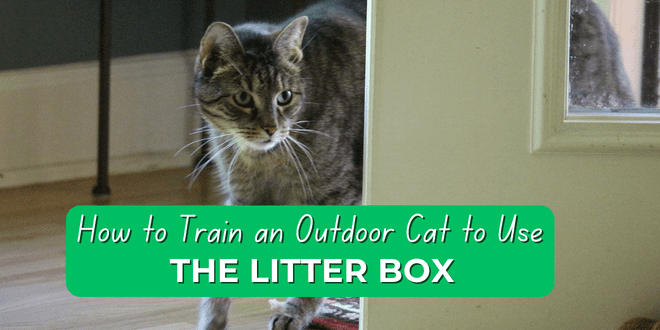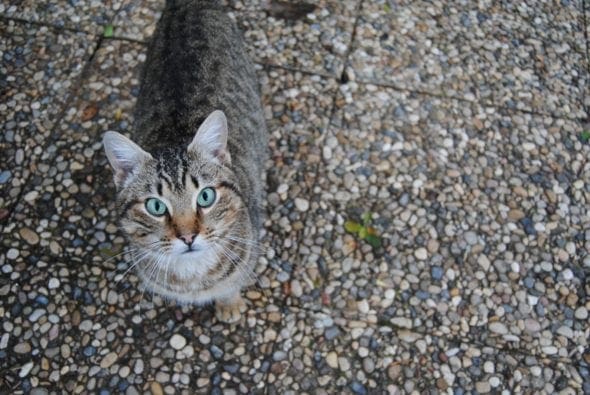
If you’re transitioning an outdoor cat to indoor life, you may be initially concerned with how to train the cat to now start using an indoor litter box. For some cats, the transition to a litter box will be very easy but for others, it may take a little more finesse on your part.
Start With an Appealing Litter Box
Look at the box from your formerly-outdoor cat’s point of view. When the cat was outdoors she had the wide open spaces when it came to choosing an elimination spot. The box you choose as the new indoor box should be:
uncovered
easy to find
All-too-often, when it comes to litter boxes, cat parents choose types that are appealing based on human convenience but not cat convenience. A covered box or a self-cleaning model may be too confining, too noisy, too small, or just too confusing when an outdoor cat is learning Litter Box 101. Box size should be:
large enough for the cat to completely stand inside and move around
good rule of thumb is one-and-a-half times the length of the cat

Photo by Sara Morán on Unsplash
Typically, many of the litter boxes on the market really aren’t big enough for most cats. In that case, get a plastic storage container instead. You can choose one with very high sides to control litter scatter. Cut an entrance on one end of the box so it’s easy for your cat to go in and out. Also, don’t use liners in the box. Cats generally hate those and a cat will probably just be frustrated and confused by them.
Correct Number of Litter Boxes
Ideally, a cat household should contain the same number of boxes as cats plus one additional. If you’re transitioning a cat to the indoors, make it even easier for her to learn by providing more than one box. In the outdoors she was used to being able to eliminate anywhere so the indoor boxes need to be easy to find. Don’t create so much privacy that the boxes become forgotten.
Type of Cat Litter
An outdoor cat who has never used a litter box is more familiar with soil, sand, and unscented substrates. Your best bet is to choose a very soft sand-like, unscented scoopable litter. This isn’t the time to attempt to use alternative litters, pellet-style, or crystal litter. Cats can have texture preferences and an outdoor cat is most likely used to the softness of soil, so a soft, unscented scoopable litter will be similar.
If the cat isn’t using the litter box and you’re unsure just what substrate to use, set out a few boxes and offer several choices.
Location of Litter Boxes
Put one box by the door initially so when your cat goes near the area in an attempt to get outside for elimination, she’ll see the litter box conveniently located. Place another box in the area where the cat spends the most time (but not right near the food).
In some cases, it’s best to confine the cat to a small area of the home until you’re sure Litter Box 101 lessons have been mastered.
Avoid Confusion
When outdoors, soil was readily available as a substrate. Now indoors, the cat may be drawn to the soil surrounding your large potted plants. To avoid confusion and prevent your plants from becoming makeshift litter boxes, cover the soil with large, smooth stones to discourage kitty from attempting to dig there. Make sure the stones are heavy enough that the cat can’t push them out of the way but you can still easily water the plant. The other option is to move the plants to a room where your cat can’t access.
Be Patient With the Cat
The longer the cat has been used to eliminating exclusively outdoors, the longer it may take for her to get the hang of now using a litter box. Don’t punish for mistakes or else you’ll create a fear and that will set you back in the training and trust-building process. Instead, make any necessary adjustments in the set-up and the environment to help the cat succeed.
If your cat defecates outside of the box, place a small amount of the feces in the litter as a helpful reminder. Normally, you would want to keep the box pristine, but your litter box novice may need a little extra help right now.
If you have a question regarding your cat’s health, please contact your veterinarian. This article is not intended as a replacement for your cat’s veterinary care.
 Problem Solving & Advice by Pam Johnson-Bennett Cat Behavior Expert & Best-selling Author
Problem Solving & Advice by Pam Johnson-Bennett Cat Behavior Expert & Best-selling Author

